Rounding up some "parts" Sega Genesises
Tags: console sega genesis pickups
As part of a project to repair a badly-hurt JVC X’Eye, I’ve been looking for “parts” Genesis IIs to harvest a 315-5660 VDP chip from. Unfortunately, the Genesis II seems to be quite the tough customer. I keep fixing the parts machines before they can be sacrificed.
Although a Genesis II is probably less valuable than a working X’Eye, it still seems like a shame to “kill” a working machine to resuscitate it, and a machine that only needs 2-3 hours of work to bring back might as well be working in my book. There have to be limits, however, so I thought of conditions where I wouldn’t try valiantly to save a Genesis and would rather tear it apart.
- With the broken-trace Genesis, I was working on it for several days on-and-off. It wasn’t really economical to bring that one back, so “multiple days without an obvious diagnosis” qualifies.
- Same goes for if a cartridge port is mangled beyond functionality; I don’t want to re-do 64 solder joints to replace the slot with a working one. That’s the kind of failure that I would expect to actually scrap one of these machines.
- An irreplaceable part is broken. This one’s hard, since other than the Sega VDP, I don’t think anything in a VA1.8 Genesis can really be considered “custom.” 68000, Z80, work RAM, VRAM, RGB encoders: I have spares or can easily get spares for these.
Genesis #1
A friend of mine in another city picked one up at my behest for $20; it was sold as broken, because the controller was always pushing the down arrow. When it got to me and I tested it, I saw no such problem. The third-party controller it came with was really gross, so I cleaned the pads of the controller with printer paper and washed the shell until it was clean again.
Without even opening the machine, Sonic 2 was happily playing with no problems. I put the machine aside and started looking for more parts consoles.
I still have no idea what board revision this is since I didn’t even have to open it, but consider it FIXED.
Genesis #2
I went to a local retro game store and asked if they had any “for parts” Genesises. They didn’t, but someone else hanging near the counter overheard me ask, and did. After a little negotiation, we decided that I would trade my leftover broken Super Famicoms for their broken Sega Genesis IIs. I also decided to trade an extra one on the spur of the moment for a seemingly-broken “High Definition Graphics” Genesis 1, long a white whale of my personal collection.
This Genesis 2 came with the following warning written on it: “No Image.” Presumably, when it was fired up it would never display any image and sometimes wouldn’t even be detected by the TV as a valid signal. Assuming that it was in fact broken, I took it apart without testing.
I don’t think anyone had been in this machine before; the screws let loose with a crisp snap which you usually only see with factory-torqued screws that have been sitting a long time.
This Genesis has a “VA1” motherboard, a little older than my usual VA1.8s, but pretty much the same, including a 315-5660 VDP like the one I was looking for. But what was wrong? Inside the machine, I saw some chalky white goo bridging some pins of a few of the resistor nets in the audio area of the board. It cleaned up easily with isopropyl alcohol, as did some leftover flux which looked like a bodge on a few surface-mount caps. Some of the solder also looked cold, but I figured I’d take the iron to it after a test.
After pulling the board out and looking at the underside, nothing looked particularly bad. I plugged it in with a new Genesis II AV cable, and fired it up to the TMSS screen and a working game of Columns.
I played with it for a few minutes, tried wiggling the ports and the board to see if I could get it to drop the video, and apparently this was fixed. A little anticlimactic to be sure, but I’ll take it.
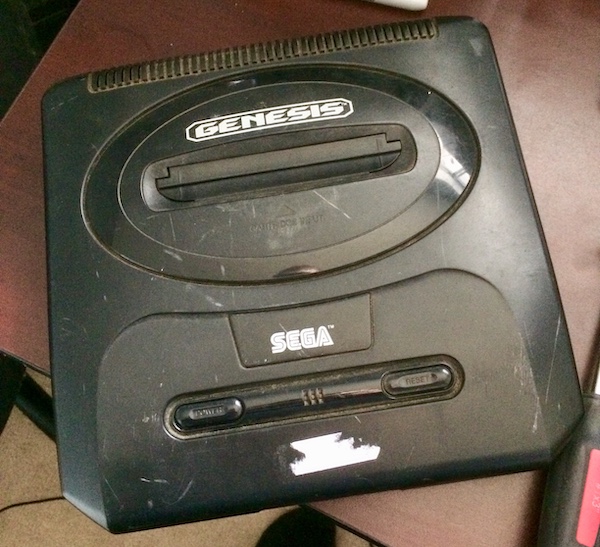
Other than the road-rashed shell, this Genesis is as good as FIXED.
Genesis #3
This machine was described as “no input.” Knowing that the Genesis controller ports liked to break their solder joints under rough handling (for instance, falling off a table onto the floor or getting yanked hard by a passing dog), I figured that this was what the problem was. Indeed, plugging my test controller in and giving it a wiggle had a really worrying amount of play in the port.
Testing with Columns proved that controller 1 wasn’t working; I plugged in on controller 2 and was able to at least skip the Sega logo, so the problem seemed localized to controller port 1. If I held the controller cord in at just the right angle, START, Left and Right would work properly, but sometimes not otherwise. The reset button also needed a surprising amount of pressure to activate.
I made a sticky note and moved on. As an aside, someone paid $22 for this at Cash Converters (a now-defunct chain of medium-tier pawn shops) long ago. Makes me super nostalgic for that era of my life, where I was able to harvest armfuls of boxed Genesis games for a fiver each.
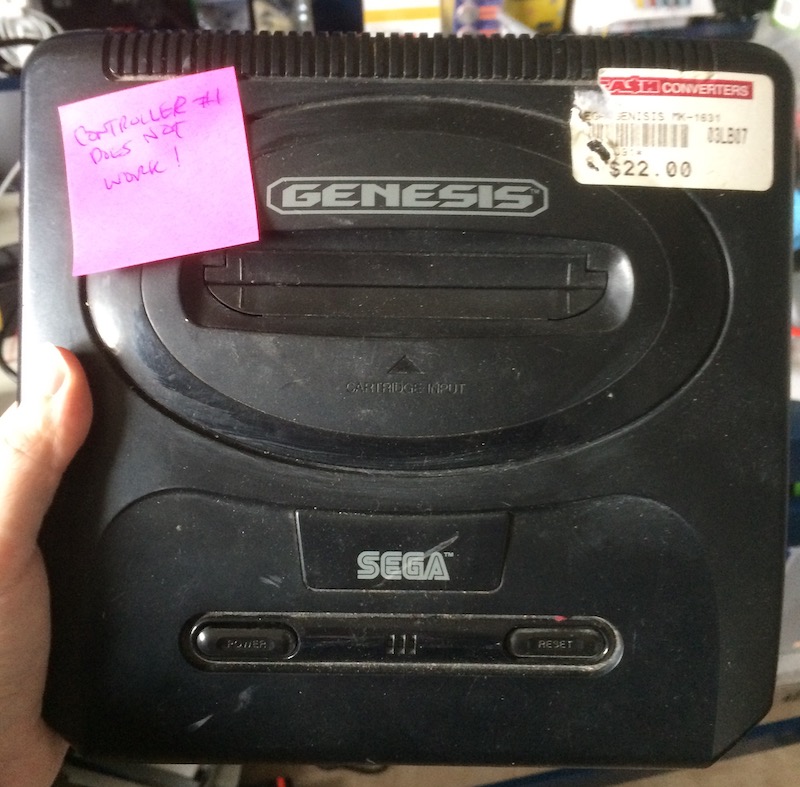
When I opened this one up, I found out it was a VA3 - so the VDP is a 315-5700. At least the number of pins is correct, though I have no idea what they changed. This machine was made in 1996, which makes it one of the newest Genesises I have.
The controller ports had this weird red stringy goo on the screws. I’m guessing it’s some form of Loctite or similar thread locker, though this definitely seems contrary to how it’s supposed to be applied.
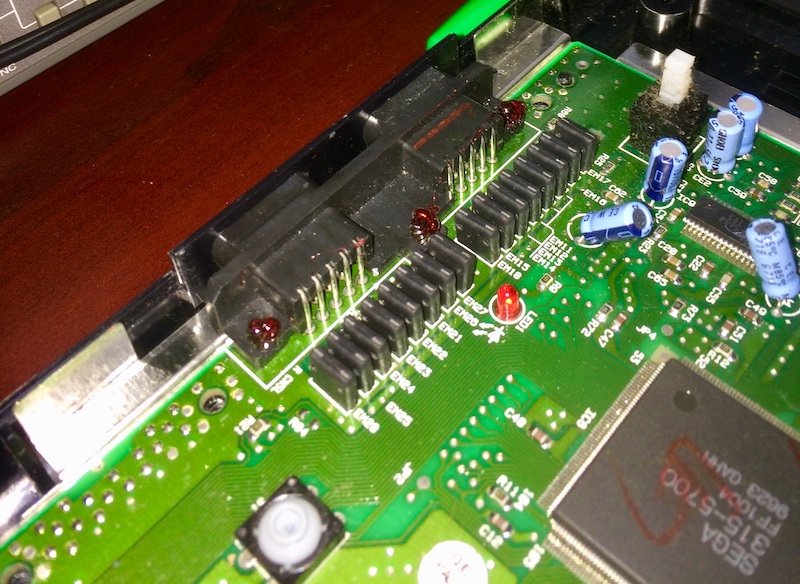
It also had this weird blotch of dark green - maybe a solder resist repair at the factory? - on the copper layer near the cartridge slot, which I hope isn’t going to cause any problems later on. I thought at first it was corrosion, since it seems a ton of gross stuff gets dropped down the cartridge slot onto the motherboard:
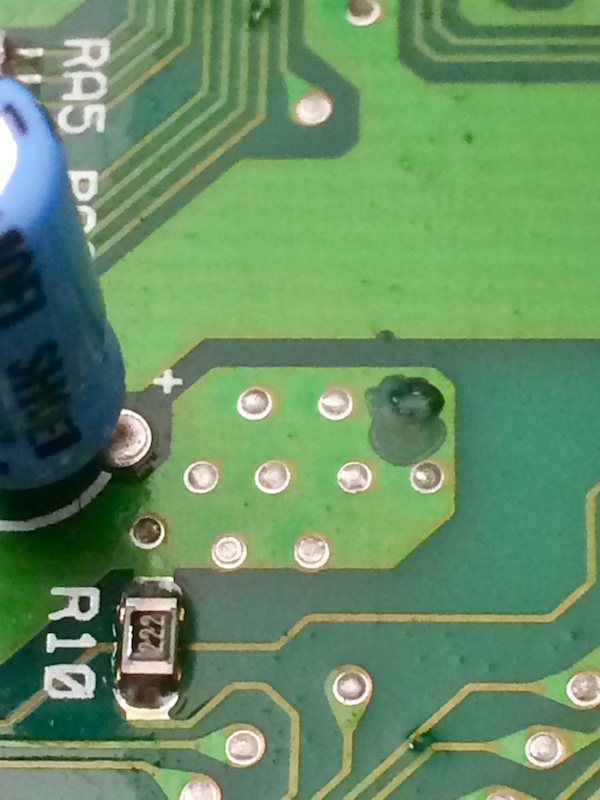
I think this one is FIXABLE, with a reflow of the controller ports. For now, though, I wanted to move onto #4, to see if that would provide me with my desired 315-5660.
Genesis #4
Here is an actual challenge! This Genesis was described as not working at all, and when I plugged it in, it didn’t want to even turn on. No power? Perhaps something truly dastardly has happened.
When I turned it over, I noticed another note attached to it, saying that the joints had been reflowed but it didn’t fix the console. A hypothesis of a “broken trace” was submitted as well. Having already fixed a broken trace before, I decided to take it apart, if for no other reason than morbid curiosity.
The first problem I encountered was that this is actually a VA2 Genesis II. I had thought that all Genesis IIs would have the 315-5660 VDP, but this one doesn’t! On my VA1 and VA1.8 machines, the YM2612 sound chip is part of the VDP, but here it is discrete. I can’t use a 315-5786 to replace my 5660, so this is worthless as a parts machine.
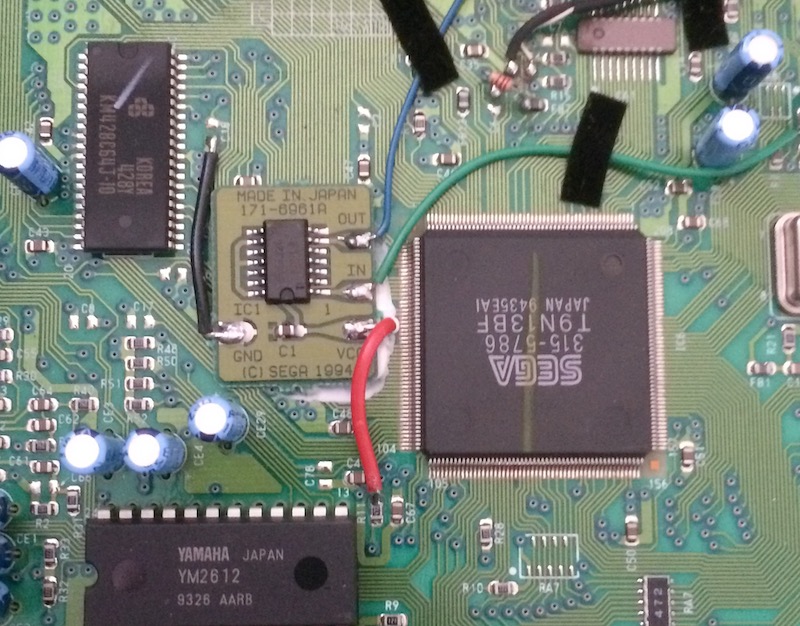
And Sega put this weird patch board on it with a bunch of wires running everywhere! What the hell is going on?
At the very least, I resolved to fix this machine, to see if maybe it at least sounded cooler than my supposedly-farty, internet-hated VA1.8s. When I flipped the motherboard over to take a look at these “reflowed” joints, I saw this.
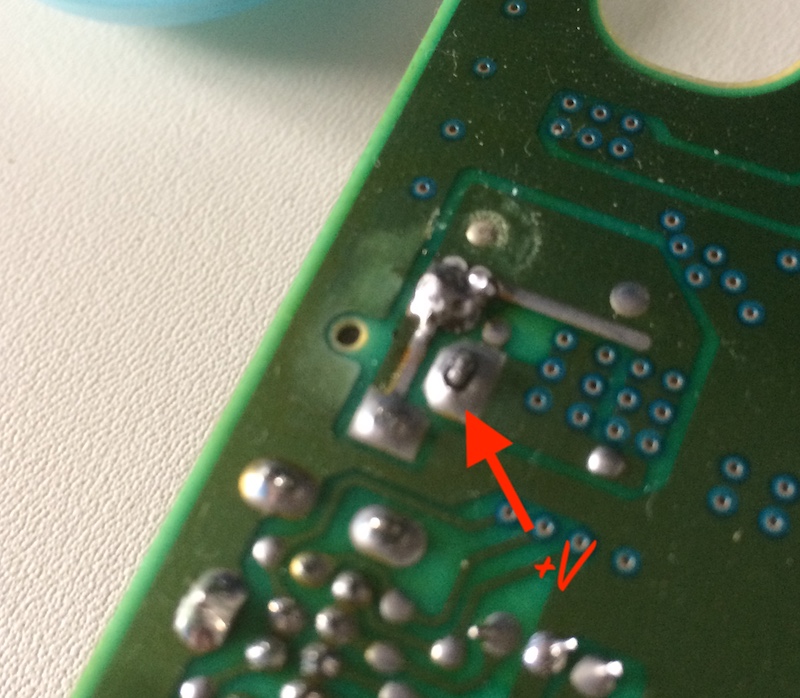
Something clearly went wrong when trying to reflow these joints; it looks like a bunch of solder got globbed up here.
Not only is there a cold solder joint here, but it looks like the power jack has been burning up! I couldn’t even get solder to stick to the positive leg, and once I desoldered and removed the jack, I soon found out why.
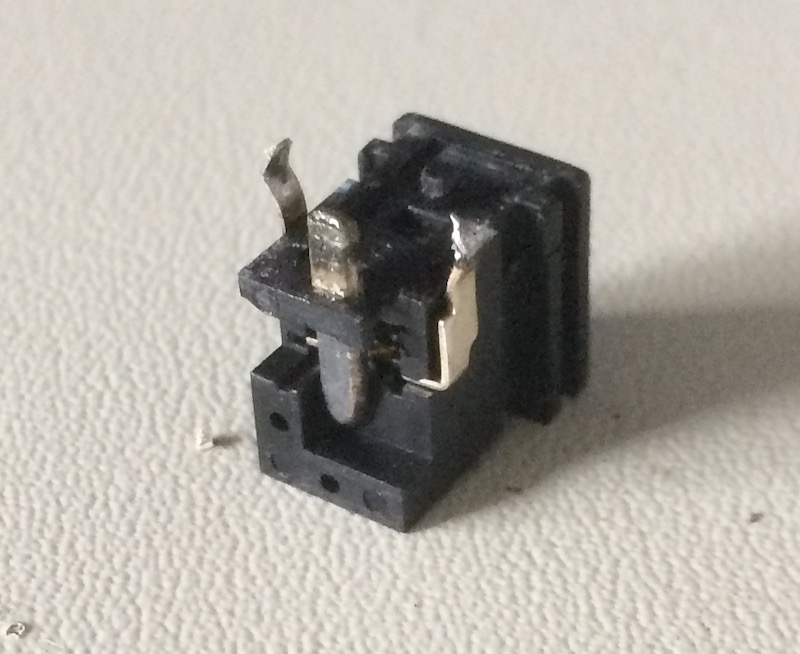
With the amount of scorching on this poor jack, there probably wasn’t any conductivity happening anymore. I bet it was loose, arcing across the solder joint and barely working. Whatever’s really wrong with this machine will need a new power jack to diagnose. Luckily, they’re only like a buck-fifty on Digikey.
I think this one is also FIXABLE. Or at least, it’s not a good parts machine for my JVC.
Bonus: the High Definition Graphics Genesis 1
I’ve always wanted one of these, and making the extra SuFami <-> Genesis trade deal here is one of the smartest things I’ve ever done. While it presented a black screen originally, after putting some isopropyl alcohol on my Columns test cartridge and slamming it in and out of the machine in order to clean the cartridge slot, it became capable of booting a bunch of different games and running fine.
Here it is running Phantasy Star II:
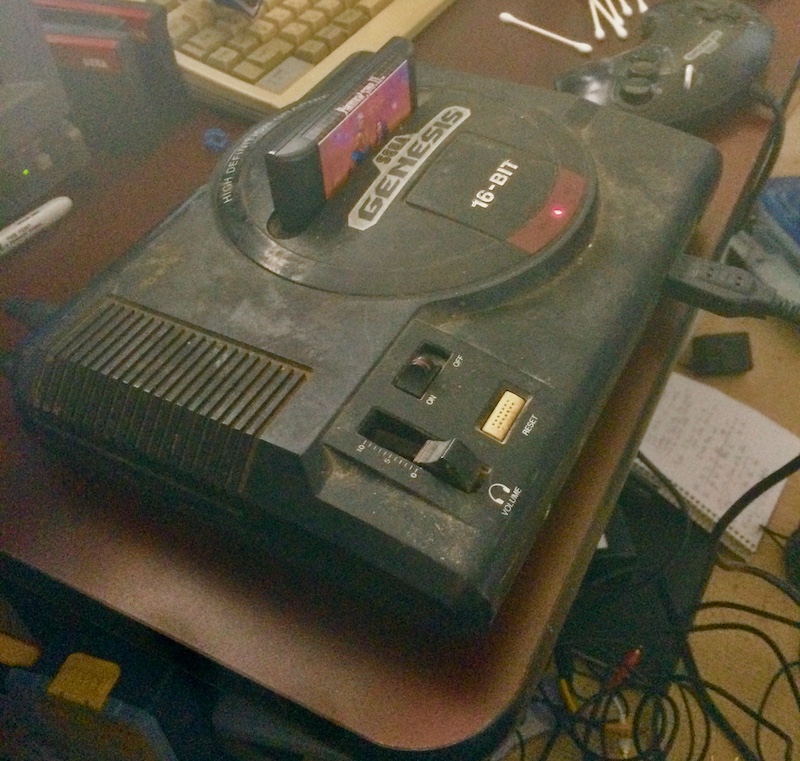
I don’t think it actually sounds any different than the Genesis II, no matter what message boards say. However, I’ll definitely tell everyone it does.
All this machine needs is a good scrubbing (it’s pretty filthy on the outside, and likely on the inside). It’s FIXED.
Conclusion
While I’m waiting on parts and time, it’s worth reflecting on the lessons we learned today.
- The Genesis II is apparently pretty tough; out of four parts machines we’ve saved two without much effort, and found two more that can be fixed with not much effort or specialized tools.
- Don’t be afraid to open up your stuff! Lots of damaged 80s consumer electronics can be traced to simple stuff like cold solder joints or crap from storage.
- As a much smarter person once told me, “If it doesn’t work, clean it. If it still doesn’t work, clean it again.”
- I still need a parts Genesis. Maybe if I buy more than four at once?
Repair Summary
| Fault | Remedy | Caveats |
|---|---|---|
| (#1) “Always pushes down” | It doesn’t. | |
| (#2) “No image.” | Cleaned motherboard, and it worked fine. | |
| (#5) Dirty. | Cleaned it. | Not very well, though. |